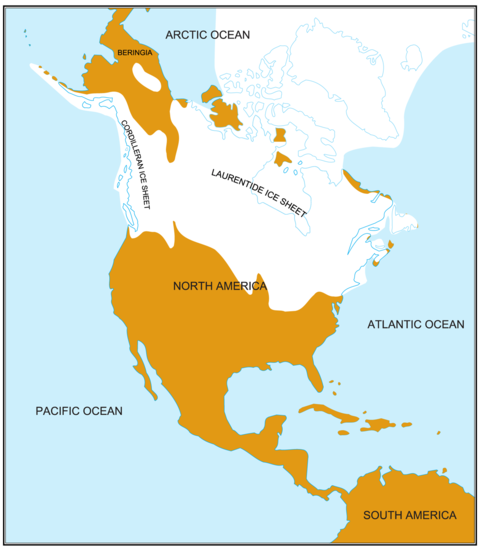About Spofford Lake:
Spofford Lake is a 732-acre (2.96 km2) water body located in Cheshire County in southwestern New Hampshire, United States, in the town of Chesterfield. Water from Spofford Lake flows via Partridge Brook to the Connecticut River.

A Glacial History:
Spofford Lake is considered to be a glacial lake. Glacial lakes are formed when a glacier erodes the land, and then melts, filling the depression created by the glacier. Near the end of the last glacial period, roughly 10,000 years ago, glaciers began to retreat in New Hampshire and most of New England. A retreating glacier often left behind large deposits of ice in hollows between drumlins or hills. As the ice age ended, these melted to create lakes. These lakes are clearly visible in aerial photos of landforms in regions that were glaciated during the last ice age. The coastlines near these areas are typically very irregular, reflecting the same geological process. The image below shows the extent to which the Wisconsin Glaciation (in white) covered the continental US and Canada.

Sediment of Glacial Lakes:
The amount of sediment found in glacial lakes varies from four to six meters in-depth and has a general stratigraphic sequence of; organic muds, glacial clays, silty clays, and sands based on time of formation. The scouring action of the glaciers pulverizes minerals in the rock over which the glacier passes. These pulverized minerals become sediment at the bottom of the lake.
Sand:
Sand is divided into five categories based on its size:
-Very fine sand (1/16 – 1/8mm)
-Fine sand (1/8 – 1/4mm)
-Medium sand (1/4mm – 1/2mm)
-Coarse sand (1/2mm – 1mm)
-Very coarse sand (1 mm – 2mm)
These are accurate measurements according to the Udden-Wentworth Scale
Spofford Lake’s Garnets:
Garnets are minerals that are found throughout the world in metamorphic, igneous, and sedimentary rocks. Most garnets found near Earth's surface forms when a sedimentary rock with a high aluminum content, such as shale, is subjected to heat and pressure intense enough to produce schist or gneiss. Garnet is also found in the rocks of contact metamorphism, subsurface magma chambers, lava flows, deep-source volcanic eruptions, and the soils and sediments formed when garnet-bearing rocks are weathered and eroded. Most people associate the word "garnet" with a red gemstone; however, they are often surprised to learn that garnet occurs in many other colors and has many other uses.

The Aging Process of Lakes:
Bodies of water, like many things on Earth, go through an aging process.
Oligotrophic Lakes (“young lakes”) - Over several thousands of years, shorelines of oligotrophic lakes erode and become less steep. The rocks on the lake bottom grind against each other creating sand, while more plant life emerges on the shore and in the water.
Traits of Oligotrophic Lakes:
-
Steep shorelines going down to the water’s edge
-
Coniferous trees (pines, etc) around the lake’s shoreline
-
They are very deep (100+ feet)
-
The lake bottom is mostly rocky
-
The water is very clear
Mesotrophic Lakes (“middle-aged lakes”) - After several thousand more years, mesotrophic lakes gain nutrients from the fallen, decayed leaves from deciduous trees, decayed shoreline plants, decaying aquatic plants, and the remains of fish and other water creatures. The lake bottom near the shore becomes covered with silt and sediment as a result of more years of weathering and erosion.
Traits of Mesotrophic Lakes:
-
Less steep shorelines
-
A mixture of coniferous and deciduous trees around the lake’s shoreline
-
They are less deep than oligotrophic lakes
-
The lake bottom is mostly made of sand and/or clay
-
The water is very clear
Eutrophic Lakes (“old lakes”) - It is the nature of all lakes to fill themselves in and become land. After several thousand more years, your lake will continue to become shallower in the center, more shoreline will erode into the water, and trees will fall in.
Traits of Eutrophic Lakes:
-
Gentle, completely flat shorelines
-
Mostly deciduous trees (oaks, maples, etc) around the lake’s shoreline
-
They are pretty shallow
-
The water is murky because of an excessive amount of planktonic algae growth
Logging Requirements:
-
At the GZ, what types of glacial sediment are found here? Be sure to look on the beach, in the water, and near the foreshore.
-
Use the Udden-Wentworth scale to determine the average size of sand at the GZ.
-
What type of aging process is Spofford Lake in currently? Name specific signs of this at the GZ.
-
Look for any signs of red garnets at Spofford Lake. Please view the image below to help you with your search. (Hint: most of the garnets that we’ve found were near the area between the shoreline and the water). Are the garnets larger than, smaller than, or about the same size of the sand in the beach? Describe the appearance of Spofford Lake’s garnets.

Sidenote: This is probably the toughest logging task in this earthcache. The amount of garnets on the beach tends to fluctuate day by day. In the event that you may have a bit of difficulty searching for garnets, please make a prediction on how you think garnets have arrived at this lake.
5. As of June 2019, earthcaches are now allowed to have a required photo logging task. Please provide a photo of yourself, your GPSr, or a personal item that proves that you have visited this site. Please post this in your log.
Congrats to uncivilizedwhitelion for the FTF!
Pricing for Ware's Grove Beach:
Adult Daily Pass: $8
Child Daily Pass: $5
Enjoyed finding this EarthCache? Consider awarding it a favorite point!
Sources:
https://en.wikipedia.org/wiki/Spofford_Lake
https://en.wikipedia.org/wiki/Glacial_lake
https://www.goodbyetomuck.com/wiki/everything-about-muck-in-lakes
https://en.wikipedia.org/wiki/Clay
https://geology.com/minerals/garnet.shtml#:~:text=Most%20garnet%20found%20near%20Earth's,to%20produce%20schist%20or%20gneiss.&text=The%20aluminum%20garnets%20are%20normally,higher%20specific%20gravity%20and%20hardness.
| We have earned GSA's highest level: |
 |

